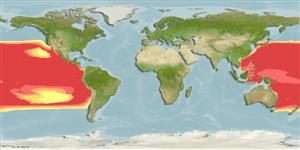>
Lophiiformes (Anglerfishes) >
Linophrynidae (Leftvents)
Etymology: Linophryne: Greek, 'linon' = flax or anything made of flax such as "cord," "rope," or a "net" + Greek, 'phryne' = "toad" (refers to a toadlike fish that fishes with a net) (Ref. 86949).
Environment: milieu / climate zone / depth range / distribution range
Ecología
marino batipelágico; rango de profundidad 150 - 2000 m (Ref. 86949). Deep-water
Indo-Pacific.
Tamaño / Peso / Age
Maturity: Lm ? range ? - ? cm
Max length : 4.3 cm SL macho / no sexado; (Ref. 27311)
Metamorphosed females distinguished by the following characteristics: escal bulb with distal pair of fringed anterior filaments; medial distal papilla with short filaments present; one or two pairs of stout distal posterior filaments; simple tapering appendage emerging from behind escal pore; barbel with short, stout, undivided stem, length 10-17% SL to base of series of 5-6 short branches, each with a number of branched filaments at distal tip; filaments and transparent distal part of primary branches with numerous, small, globular luminous organs, internal, sessile, or set on short stalks; lower jaw without symphisial spine. Males without pointed sphenotic spines. Larvae, males and juvenile female with two lateral rows of large subdermal melanophores along side of body, with concentration at base of caudal fin (Ref. 86949).
Also mesopelagic (Ref. 7300).
Life cycle and mating behavior
Madurez | Reproducción | Puesta | Huevos | Fecundidad | Larva
Paxton, J.R., D.F. Hoese, G.R. Allen and J.E. Hanley, 1989. Pisces. Petromyzontidae to Carangidae. Zoological Catalogue of Australia, Vol. 7. Australian Government Publishing Service, Canberra, 665 p. (Ref. 7300)
IUCN Red List Status (Ref. 130435)
Threat to humans
Harmless
Human uses
Más información
Nombres comunesSinónimosMetabolismoDespredadoresEcotoxicologíaReproducciónMadurezPuestaAgregación para la puestaFecundidadHuevosEgg development
ReferenciasAcuiculturaPerfil de acuiculturaRazasGenéticaElectrophoresesheritabilidadEnfermedadesProcesamientoNutrientsMass conversion
ColaboradoresImágenesStamps, Coins Misc.SonidosCiguateraVelocidadTipo de nataciónSuperficie branquialOtolitosCerebrosVisión
Herramientas
Special reports
Download XML
Fuentes de Internet
Estimates based on models
Preferred temperature (Ref.
123201): 4.2 - 11.1, mean 6.7 °C (based on 507 cells).
Phylogenetic diversity index (Ref.
82804): PD
50 = 0.5000 [Uniqueness, from 0.5 = low to 2.0 = high].
Bayesian length-weight: a=0.01000 (0.00244 - 0.04107), b=3.04 (2.81 - 3.27), in cm total length, based on all LWR estimates for this body shape (Ref.
93245).
Nivel trófico (Ref.
69278): 3.4 ±0.6 se; based on size and trophs of closest relatives
Fishing Vulnerability (Ref.
59153): Low vulnerability (10 of 100).
